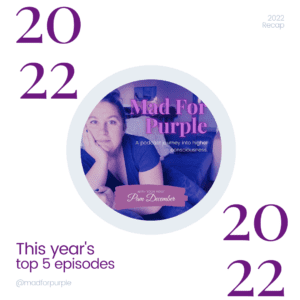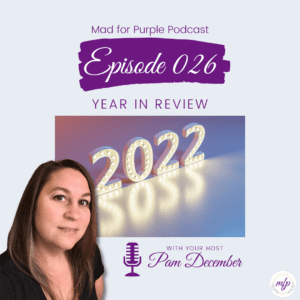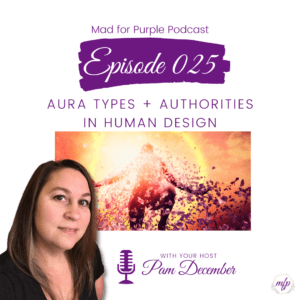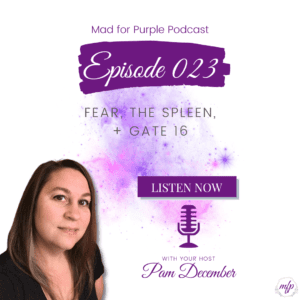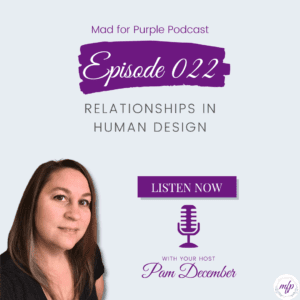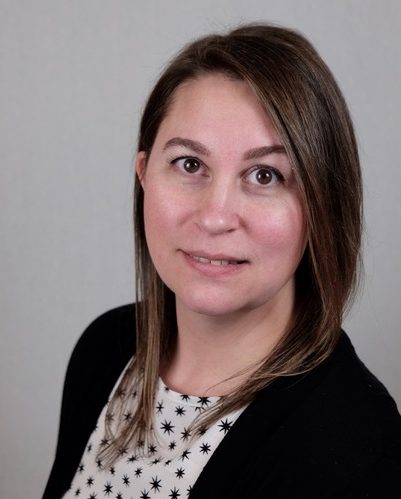Episode Transcript:
[00:00:00] In that observing and the allowing that it’s okay to be different. It’s ok for your body to feel different. And what’s better yet is having access to this tool to help one take care of their body in a different way. To take care of their energy in a different way. And in doing this deepening, this ability to self-actualize. This ability to tap into inner truth and strengthen those boundaries of being the individual that each of us is.
[00:00:39] Hello everyone. And welcome to another episode from Mad for Purple. I am your host, Pam December. And today, I’m going to be talking to you about how to strengthen your aura, using Human Design. Now this information comes from the Four Radical Transformations which has to do with the variables in your chart. Specifically the Primary Health System or PHS environment, which is determined by your design north and south node calculations that are below the line number.
[00:01:09] Now, this information is shown on advanced Human Design charts. So what you’re going to look for, if you’ve gotten a chart from me or from Genetic Matrix, what you’re going to do is look on the left-hand side towards the bottom there’ll be a label that says environment. And your environment is going to be one of 12.
[00:01:28] If you don’t have your chart already I’ll leave a link in the show notes or in the description of how you can request me to pull a chart for you. But I’ll also do is put a chart on my website so you’ll be able to find that madforpurple.com, episode five. I’ll make sure and link that too, so that you have something to look at while you’re listening to this episode.

[00:01:48] So with any of the Human Design information that I bring forward, strongly encourage you to follow your strategy and authority in taking it in because you are your own authority. Now with any of the Human Design information, it may resonate, it may not. If it doesn’t, it might be just a timing thing. It’s not time for you to incorporate environment in your experiment, or it’s just not correct for you. Both are valid.
[00:02:13] So with the environment information, it’s not always going to be possible for us to live in our environment, but if we can at least create artificially in our homes or access, those environments is going to be very helpful.
[00:02:24] And the other thing is that this becomes more important after the Saturn return, which is around 29 to 30 years old. So if you haven’t reached your Saturn return yet, this would just be good to note for future use. So Human Design environment protects the aura and the long-term wellbeing of our bodies.
[00:02:42] It takes the pressure off of the natural deterioration of the body and that deterioration or the breakdown is what creates health issues. So the more pressure we can take off the potential for better health we have. By being in this correct environment is going to be very nourishing on so many levels. For your aura, for your body, for your perception, for your digestion, for your cognition.
[00:03:09] And the cognition is what we’re really looking to support through the Four Radical Transformations as your cognition is your superpower. So being in the correct environment, your body’s meeting less resistance, making it easier to tap into that body consciousness, into your strategy and authority. And I was saying, if you can’t actually live in your environment or spend a bunch of time on a daily basis in that environment purposefully going to those environments to recharge.
[00:03:36] So there is a lot of homogenization that we’ve all received around housing and lifestyle. So there’s a good chance that you’re going to meet some resistance in implementing your environment. One of the challenges of self-actualizing, of following your design, of living this Intel, because it is highly individual it often goes against the grain of our friends, our family, our colleagues.
[00:04:01] So in protecting the aura in strengthening the aura, it’s helping with our energetic boundaries and being able to live true to ourselves. True to what’s correct for us as individuals. So I just ask that you remain open-minded as we go through this, especially if this is brand new to you, because there needs to be this recognition for there to be a response and we’re looking to be responding to life versus reacting.
[00:04:27] So we have six environment types and each type has an active form or a passive form. So the active form is always going to be more, well more active, but it’s also about structure being strategic, purposeful, engaged. It’s going to be more busy-ness in moving around the environment. It’s going to be more focused and all of these things bring out your own activities.
[00:04:53] So it’s like, because you’re being active and the environment is active and you’re actively participating in that environment. It keeps you moving. So it’s like perpetual motion machine, if you will. We all have to find our own balance in our charts and in how we live and what that looks like. But just knowing that for the active environment, you’re an active participant in that environment.
[00:05:15] Where on the other side you have passive and the passive is going to look more like a couch potato. They’re going to be sitting back munching on their chips. Maybe not chips, maybe it’s carrots, but so that they are relaxed and just taking everything in, in a very passive way. It’s like the environment is happening around them, not to them, around them for them.
[00:05:37] And it’s very relaxed. Slow paced, easy going kind of way. There isn’t the structure or the strategy of moving from one room to the next, for example, or moving in and out of the environment, this ability to sit back and relax and just be is where the next steps and next sign posts, the breadcrumbs from the universe are going to show up. Where the active person, those signs and symbols and things like that show up because they are actively participating and moving in their environment. I hope that makes sense.
[00:06:10] Our first environment is called caves, now this is the colour one. Now, if you don’t know what colour is that’s okay. Don’t worry it will come. Caves environment is a hardscape environment. Thinking of like the first humans we were living in actual caves, our whole family’s like you’re talking like 50, a hundred people all living in this cave, like environment.
[00:06:31] So you think of like a city and because this is the number one energy, it’s about fear, control, security. So all of those keynotes lend to the environment. So when we’re talking about like control of temperature, control of lighting, control of who can come in and out of the space. Those things are all going to lend to the security, that the vehicle, the body is going to feel.
[00:06:57] So think like environments in our modern world, you’ve got apartment buildings. And then if you come in even further, you’ve got rooms, closets, bathroom vehicles. Now I don’t know a caves person that doesn’t love the vehicle. Not only is it temperature controlled, we also can lock the doors and control who comes in and out.
[00:07:16] So for the selective or natural caves person, this is the more active environment that I talked about earlier. They’re very private. One door in and out of a space is what’s going to feel most comfortable. So that means you have closet doors and a door in and out of your bedroom, you’re probably going to want to see what it’s like to remove those doors. See how the body feels.
[00:07:39] Be super picky about who you let into your house, into your vehicle, into your office. And remember this is an active environment so it’s more of a moving around in your environment, being an active participant in your environment, versus just sitting back and watching.
[00:07:54] Now our caves blending or artificial people, are more open to who comes in and out because they need people around to be able to watch, right. It’s more of a relaxed, easy going, slower paced. For myself, I am caves blending. What this looks like for me online, for example, is being in groups, not necessarily my own, but other groups, small groups, where I can observe other people going through their processes.
[00:08:21] What it means in my own Facebook group is posting questions and things like that for people to respond to, so that I can observe their responses. I’ve set up three cave like environments within my house. So my office, if you’ve ever been on a call with me, you know, that 95% of the time, the light out and I’ve got natural light coming in creating this beautiful, either pink or purple background.
[00:08:45] I’ve let go of the expectation that videos are done with good lighting, because having one of those ring lights blaring in my face while I’m trying to have a conversation is not supportive of my body. So being in natural light, as much as possible when it comes to my bedroom, I have to sleep with my door shuts the only way that I feel safe and secure.
[00:09:08] And it’s not that I have like, anxiety about going to sleep or anything like that. It’s just that’s I closed the door and that just feels better. Yeah. There’s a different even air pressure within a room where the door is closed, but I feel is something to do with caves person.
[00:09:22] It’s like, if you’ve ever stayed at a hotel and you’ve walked into a building that is made of concrete, the resonance of the air and the energy movement is much different than a wood structure. Or even if you’re just outside in an open park. The bathroom is a, another cave. One of the things that I find super nourishing is to have a bath using candlelight.
[00:09:47] And what I’ve done for the rest of the home is like for this winter, this would be the second winter I’ve left my temperature higher than what I would have in the past, as I’m not thinking about, oh, I need to conserve energy. I need to keep my gas bill low. No, I keep my house at an even temperature. My body just feels more comfortable and I guess that’s one of the things that I didn’t really stress during the intro of this episode is it’s about the aura cause the aura helps protect and nourish the body.
[00:10:15] And because this is coming from the design side of the chart is all about the body. So although this episode is about aura, it’s also about the body. Going back to the temperature. When you think of an actual cave, it’s going to have an ambient temperature, but it’s going to stay pretty much all year round. So that’s what I’m emulating with my thermostat. Something for the rest of you caves people to experiment with.
[00:10:39] The one last note on caves is the number of people that you’re living with. Now, if you live in an apartment building, you’re going to be contacting number of auras through the walls, through the floors, through the ceilings, that kind of thing, depending on how high your ceilings are. But even like moving in and out of the building, you’re going to be coming in contact with other people. And you’re built for that.
[00:10:58] You have higher immunity for coming into contact with other people and living with one other person that’s going to be supportive. Not only from a security standpoint, but our mechanics standpoint of physically interacting with somebody else’s aura.
[00:11:12] The next we move into markets. Now this is also a hardscape environment. So urban city kind of environment, where you are coming into contact with lots of different people, places and things, being exposed to different people and that lending to how your immune system works.
[00:11:30] So for the active markets, we have markets internal. So now when we’re talking about markets, we’re talking about the farmer’s market, the stock market, online markets. This is all about business and making money, the exchange of resources, city living. So thinking about how can you bring more exchange into your life, into your home, into your business?
[00:11:54] The environment of exchange. So we have internal markets, which is the more active of the markets. So it has to do with bringing people to you, thriving in hustle and bustle, but that hustle and bustle, like you’re creating it and bringing it to you through this very strategic focused, busy, active kind of way. So think of like a home-based business, you have people coming to your home to exchange resources
[00:12:21] For our external markets, this is the more passive market. So this is about being in, going to the hustle and bustle being above a business. Like, if you had an apartment above a business that might be supportive for you. Playing the stock market and going to the business, going to the markets versus the internal market where you’re creating that and bringing it to you.
[00:12:46] The external market’s going to, to be able to observe it be in it. And in that observing and being in the hustle and bustle being very discerning about who you’re exchanging goods with, who you’re exchanging resources with. So you are allowed to be very picky about who you buy from. So again, with internal and external, how can you bring more exchange into your life on a daily.
[00:13:13] And the next environment we come to as kitchens. So again, this is a hardscape environment. This is an urban kind of setting where it can mean actual kitchens, but it’s really more about bringing people and places and things together. This is more densely packed with people, places and things. Temperature on this one is important.
[00:13:31] Again, I think the main thing to understand about these two kitchen environments is about alchemy, but mutation it’s about transformation change. Because for example, if you were wet kitchens, your body is going to be more dry. So it’s looking for the lush green environments, the wetness, the humidity. So that your body transforms that energy, that environment as your body takes it in and it dries it out. Right?
[00:14:00] So you’re mutating that wet environment into dry energetically in the body. Since we’re talking about wet, wet kitchens is the more active of the kitchen environment. What does that mean? Lush green environments. You don’t have to necessarily live in the kitchen, but it should be a place that you love.
[00:14:17] And yes, this humidity, this wetness and in an urban kind of environment that evolved out of the marketplace. So it’s about the quality of the place. It can be like a messy workshop. Even though like, this is the strategic focus kind of energy, it’s messy and it’s juicy. And it’s the energy of change of being in that, moving with it.
[00:14:42] It’s a messy kitchen. The next time you could bring on the mess. I’m thinking of like making bread and kneading you have that you need the humidity and the wetness for the dough to rise, right? And there’s this incredible transformation from flour and water into a loaf of bread. With all these dry ingredients making them wet and then drying them out again in the oven.
[00:15:02] On the other side of the spectrum, we have dry kitchens. Now, this is your body is more wet, more humid. So it’s that transformation from dry from your environment that desert like environment bringing it into the body and rehydrating. So this energy is about preservation wanting to preserve something.
[00:15:23] So this could be actual like in the kitchen making jam, making pickles. And even though all of this and the more passive of the environments, it’s still, it’s sterile. It’s more precise. We have the messiness of the wet kitchen, but we have the precision and the impeccability of the dry kitchen. And this precision and this being, because again, this is passive this isn’t about doing, this is about being relaxed and observing.
[00:15:48] So what do you want to preserve? What’s being called to be preserved. Now this could be, like I said, it could be food, it could be a tradition. It could be, it could be memories. Taking this thing that’s live and real and moving and alchemizing it into something that can last forever. Again, that alchemy that transformation.
[00:16:07] So from the colour three of the kitchens, we move into colour four of the mountain. Now when we move from three to four, and then you look at human evolution. So went from the cave, to the exchange of goods in the marketplace, and then from the marketplace, we have fire in the kitchen and we transform this food from one thing to another.
[00:16:28] And as we’re doing this, like we’re in these city kind of environments, these more densely packed environments, these more people-ie environments. Now from the three to the four we’re moving away the city away from that urbanization and back to nature.
[00:16:43] So colour four mountain, every mountain person that I’ve talked to, this is like actual mountains. There’s going to be some suggestions on how you can create artificial mountains or live in the penthouse suite of an apartment building or condo building. All the mountains, people that I’ve talked to like actual mountains is what nourishes them. So things that you can try if you don’t live in a mountainous area is do you have access to mountains that you could make weekly trips bi-weekly?
[00:17:11] Any trips is better than no trips to get into the mountains to really fuel. Fuel yourself, release any energy that’s not yours out of your aura, out of your energetic body and recharge that boundary recharge the body. So things that you can do your bed, get a high bed. Like if you have to build an extra platform or whether you have like one of those mattresses that’s like three or four feet deep that gives you height when you’re sleeping. Right?
[00:17:35] When you’re at a restaurant or maybe you’ve been in your own home. If you have bar stools, try and sit on barstools or any place that keeps you elevation over the rest of the environment that you’re in. Another way of emulating that is if you are in an office or you have a multi-story home being on one of those upper floors, being able to look out and down on the outside environment.
[00:18:02] So again, we have an active and passive side of mountain, and this time actually, that’s what it’s named. So mountains active. So instead of like with the markets and kitchens and being in the nitty-gritty, you’re meant to be up the mountain up above that and being able to look down on it, not necessarily to observe what’s going on in the nitty-gritty, but has a lot to do with people being able to see you and them having to come to you.
[00:18:29] They have to put in the effort to climb the mountain, get to you. So, as you can tell where moving from this physical rendition of mountains to the philosophical to the perception of mountains.
[00:18:41] So these next three colours, not just about physical location, it’s also about your nature. So the mountains needing to be above and needing to be able to look down. Not being in the nitty gritty, but the active mountains is still active. So there’s still that strategy, that focus when you’re doing your thing and you’re being busy in your own thing. And that’s, that’s going to attract people up the mountain to you attract your network.
[00:19:03] And then on the other side, we have passive mountains, again, this more relaxed with more laid back, observing the nitty gritty, observing with people, coming up the mountain and finding a very passive way. Because you’re actually looking at the big picture and taking everything else in peripherally.
[00:19:19] And in that big picture that seeing from above seeing those breadcrumbs and signposts that the universe is sending you. So the other keynote on this observing how alcohol affects you because mountains people don’t necessarily need as much oxygen. If you think of the mountains, elevation, the air getting thinner where alcohol actually completely cuts off that oxygen to the brain. So just something for you to observe experiment with. If you drink alcohol, is that correct for you or not? This is simply about supporting your aura in your body.
[00:19:53] The next environment we come to is valleys. And this is colour five. So again, this can be about an actual valley. It’s also about transition. So for the narrow valleys, where can you be in places of transition and actively participating in those transitions?
[00:20:12] So you may be in a city that’s in a valley for example, but it also has to do with the sound of transitions. So like living near a bus station, you can hear transition again with creating environments. You can do that with your bed. If you have a tall bed, put the mattress right on the floor. If you have the opportunity to, to sit on the floor, to eat, have a go at that and see how that feels, or also do better with fewer auras around.
[00:20:40] So are you in places where you can choose to interact with other auras or observe other auras versus being in that hustle and bustle that we see in caves, markets and kitchens. So back to narrow valleys, this is the more active of the two. So actively watching and hearing the flow of people. Headsets are something that may work well for you, because you can control the sound. You can control what you’re listening to, but hearing that flow of the busy-ness is what is going to help keep you moving.
[00:21:14] On the other side, we have wide valleys. They say this is more of like a natural valley setting. So living in like a small town that is well connected because you have this transition of people and things, right? You might enjoy headsets but from my experience in doing readings and talking with wide valleys people, it’s more open air loud speakers where you can actually feel the music against your body and your aura.
[00:21:41] And again, cause this is the more passive one it’s being able to hear these things going on, but in a very passive way, it just happens to be going on while you’re slowly moving about your environment and just relaxing and taking it in.
[00:21:55] And lastly, we come to shores, which is colour six. So because this is sixth line energy being above these wide open spaces. Be able to observe, be able to view the transitions of land to water, forest to farmland. Cause this gives the space to be able to just wonder and ponder what’s out there.
[00:22:18] Now the natural shores is the more active of the two. And like I was saying about having that transitory view an actual shore because natural water is so important to this colour is very beneficial. I have one natural shores clients that they go to the ocean every, I think it’s every Friday, like clockwork, because that is what restores them. So natural water being important.
[00:22:43] And again, this is the more active environment. So the ocean being a great example of the water is actively coming in and out the waves are coming in and out. I’m just thinking of like farmland, your watching the crops blowing around in the wind. You might find that nourishing. It’s hard not to just say the ocean.
[00:23:02] We don’t all have access to the ocean. Right. So how can we observe these other transition places that are active in the most natural environment possible?
[00:23:13] And the other side, we have artificial shores. Now this is the more passive side of shores and it noted that actual water isn’t as important, but artificial shores has less to do with actual water and less to do with the actual view.
[00:23:29] Although all the artificial shores, people that I’ve talked to do really well with manmade water, like ponds, fountains, fish tanks. And when it comes to natural water, like streams, it’s something that it’s not as big of a body of water necessarily, but it’s restorative in the sense that it is water. And because it’s a more passive able to observe or go about and know that it’s there in the periphery.
[00:23:54] So some other ways to create transitions for the artificial shore, is an example my daughter, at one point, the head of their bed was in the closet and the rest of the bed was in the rest of the room. So sleeping in that transition between the closet and rest of the room. I’ve heard other artificial shores people saying laying down in a hallway, as odd as that might sound feels very restorative because the hallway is transitioned right from one room to the next.
[00:24:25] So thinking of ways outside of the box of creating transitions within the home, within your environment, this is probably one of the easier ones to create artificially. Being able to view it in one room and view another. If you have transitions in your flooring from say linoleum to hardwood. Being in that transition area.
[00:24:46] Well, that wraps up all of the six environments each with a passive and an active category. I know it was a lot of information and I hope that you were able to relate to some of it. This is an invitation to experiment with this to see where your strategy and authority leads you. Course there’s other things in our charts that impact our aura but this is one of the most accessible ones that I have found.
[00:25:14] And in my own experiment, I have found to be the easiest to implement quickly and feel results. In that observing and the allowing that it’s okay to be different. It’s okay for your body to feel different and what’s better yet is having access to the tool to help one take care of their body in a different way to take care of their energy in a different way.
[00:25:41] And in doing this deepening, this ability to self-actualize this ability to tap into inner truth and strengthen those boundaries of being the individual that each of us is. So I hope that you enjoy this information. I know it’s a lot to take in.
[00:25:57] I would love to hear from you, if you have a different way than what I’ve mentioned in any of the environments, in creating an environment for yourself that has been restorative and nourishing, because I’m only able to share what I’ve witnessed or experienced myself. And I would love to witness you in your experiment.
[00:26:16] So some key takeaways from this episode one, your Human Design environment protects your aura and the long-term wellbeing of your body. Two, your body meets less resistance in its correct environment. Three, a strong aura supports you in being an individual, especially when going against the grain of society. Four it improves your perception, your digestion of food and information, plus your cognition. And lastly, it’s okay to be different.
[00:26:45] Thank you so much for listening. If you’d like to connect, you can find me on Instagram or Facebook @madforpurple. Also, I’m going to be hosting a live event in the Mad For Purple Podcast Facebook group in February around the different energy centers in Human Design.
[00:27:05] There’s a poll in the group right now to see which centers everyone would like to learn more about, so if that’s something you’re interested in, please join us in the group. Or you can sign up for my newsletter at madforpurple.com/links where you’ll get weekly updates of what is happening at Mad for Purple thanks again for listening. And I will see you in the next episode. .
Key Takeaways:
- Your Human Design environment protects your aura and the long-term wellbeing of your body
- Your body meets less resistance in its correct environment
- A strong aura supports you in being an individual, especially when going against the grain of society
- Correct environment improves your perception, your digestion of food and information, plus your cognition
- It’s okay to be different
Time Stamps:
- 04:27 Active Environment
- 05:15 Passive Environment
- 06:10 Caves
- 11:12 Markets
- 13:13 Kitchens
- 16:43 Mountains
- 19:53 Valleys
- 21:55 Shores
To Connect with Pam:
Instagram: https://www.instagram.com/madforpurple/
Facebook Page: https://www.facebook.com/madforpurple/
Facebook group: https://www.facebook.com/groups/madforpurplepodcast
Stay up to date & join the weekly newsletter HERE


